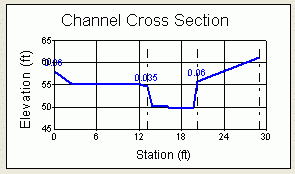Tailwater Calculations |
FishXing allows the user to define the tailwater elevation using one of three methods:
1. Constant Tailwater: Setting a tailwater elevation the remains constant as flows change
2. User Defined Tailwater Rating Curve: Inputting a rating table that relates tailwater elevation to flow.
3. Channel Cross Section: FishXing generates a tailwater rating curve based on an inputted channel cross section.
Channel Cross Section Method
The tailwater cross section method uses an inputted channel cross section to create a tailwater elevation verses flow rating table. The cross section should be located across the tailwater control below the culvert outlet. Also required is the overall channel (or water surface) slope through the cross-section and a Manning’s roughness coefficient for the channel. If the cross section contains areas of different roughness, you may vary the roughness coefficients across the section. When the cross section contains multiple roughnesses, a composite roughness is calculated.

FishXing calculates the tailwater elevation - flow relationship for the cross section assuming uniform flow, and using Manning’s Equation. Calculations begin with the tailwater set at the lowest elevation in the cross section and a corresponding flow equal to zero. Flow through the tailwater cross section is then calculated at regular intervals in tailwater elevation. Calculations end once the water surface encounters one of the cross section ends (whichever side is lower).
Interpolation and Extrapolation of Rating Curves
FishXing requires a tailwater elevation for every flow rate that it calculates. For both the User Defined Tailwater Rating Curve Method and the Channel Cross Section Method (which builds a rating curve) FishXing interpolates or extrapolates tailwater elevations associated with different flows. If the flow is between two calculated flows within the rating curve, FishXing uses linear interpolation to determine the corresponding tailwater elevation. If the flow is beyond the highest flow in the rating curve, FishXing uses linear extrapolation based on the last two points within the rating curve.
Since extrapolating beyond the curve can result in substantial error, it is always best to either (depending on the Tailwater Method selected):
1. Input a rating curve that includes the entire range of flows you plan to model (User Defined Tailwater Rating Curve Method)
2. Enter a channel cross section that will contain all of the flows you plan to model (Channel Cross Section Method)